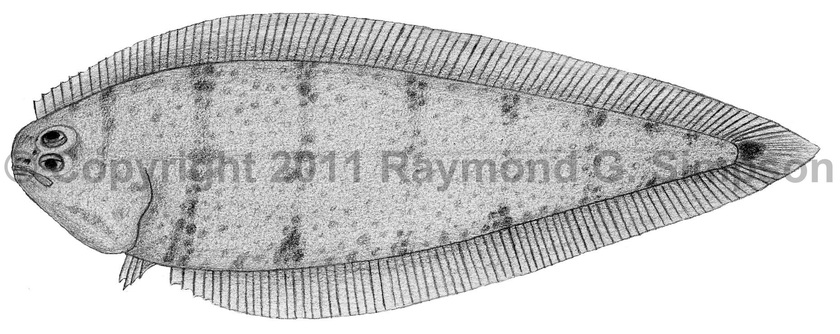
Common Name
Ginsburg's Tonguefish
Year Described
Menezes and Benvegnú, 1976
Identification
Dorsal Fin Rays: 87-95
Anal Fin Rays: 74-81
Pectoral Fin Rays: none
Pelvic Fin Rays: 4
Caudal Fin Rays: 12, rarely 10 or 11
Longitudinal Scale Rows: 87-94
Vertebrae: 50-52
Pterygiophore pattern (1st three interneural spaces): mostly 1-3-2, rarely 1-2-3, 1-3-3, or 1-4-2
Other diagnostic characters include: pupillary operculum absent, relatively large eye with narrow interorbital distance, no scales on the blind side dorsal/anal fins, teeth present on entire margin of ocular side jaw, no fleshy ridge on ucular side lower jaw, membrane ostia absent, 4 hypurals, 32-44 transverse scale rows, and 15-20 post-orbital scales (Munroe, 1998).
Color
Light brown to browish-yellow with dark melanophores on the body. There are 2-5 dark crossbands present on the body with the two bars posterior to the head being the darkest. The other bars are darkest toward the margins of the body. Opercle is the same color as the body. Peritoneum black. Fins with pigment stripes along the length of the fin, sometimes darker basally. Stripes do not continue onto the tail. Spot is present on the caudal fin base. Blind side pale.
Size
A small species ranging from 30-90mm in mature fish with few exceeding 65mm.
Habitat
A deeper dwelling species: continental shelf over mud from 103-300m.
Range Map

Range
Southeastern Brazil to Uruguay
References
Munroe, T.A. 1998. Systematics and ecology of western Atlantic tonguefishes (Symphurus: Cynoglossidae: Pleuronectiformes). Fish. Bull. 96(1):1-182.